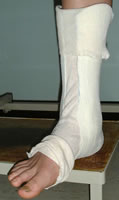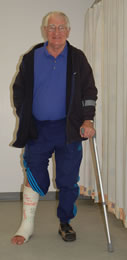
About 75% of ankle fractures are undisplaced at presentation. "Undisplaced" means the talus is congruent in the mortise, although there may be small amounts of displacement of malleolar fragments. If the deep deltoid ligament is intact the ankle will not displace. Current evidence suggests that:
Fox et al (2005) defined 2/3 of patients with undisplaced ankle fractures as stable using the following criteria:
Although such fractures may show slight talar displacement on stress testing, MR or ultrasound imaging indicates that they are very unlikely to have a complete deltoid tear.
 |
| Focused rigidity casting (FRC) ankle brace - cheap and easy to produce, fits in a trainer. |
In these fractures the risk of secondary displacement is extremely low. Two randomised controlled trial have shown that plaster treatment does not improve stability or outcome when compared with an ankle brace (Stuart et al 1989) or an elastic bandage (Port et al 1996). The long-term outcome after treatment without splintage is excellent (Bauer 1996). As these fractures do not displace, follow-up radiography is unnecessary (Michelson et al 1995, Martin 2004). Axial loading does not produce displacement (Michelson et al 1996), so there is no reason not to allow the patient to bear full weight on the ankle.
Therefore, these fractures require only symptomatic management. In practice, we find that the majority of patients are more comfortable in an ankle brace than elastic bandaging alone. The following are unnecessary and should be avoided unless clinically indicated:
Patients are encouraged to weightbear as soon as possible and to actively exercise the ankle. Follow-up is probably unnecessary.
Patients with medial tenderness often show talar displacement of several millimetres on stress testing. However, MR and ultrasound imaging shows that few have a complete deltoid tear. The clinical study of Fox et al (2005) implies that even with a complete deltoid tear some remain undisplaced with protected weightbearing, although little is known about the presumed secondary restraints.
 |
| Below-knee walking (BKW) cast - pragmatic management for undisplaced fractures with suspicion of significant deep deltoid ligament tear. Remember - BKW stands for below-knee walking |
The ideal in these fractures would probably be to define the state of the deep deltoid ligament with MR or ultrasound and possibly stress rediography. Patients with deltoid function could then be treated functionally, perhaps in an ankle brace, while those without a deltoid ligament could be treated in cast or by ORIF (we would need furthere randomised controlled trials to tell which would be best).
However, Fox's series suggests that it is pragmatically acceptable to treat patients with significant clinical suspicion of a major deep deltoid tear in a below-knee walking cast. Two fractures in that series displaced, both in the first week, so we would recommend a standing mortise radiograph at one week.
This is an area where the evidence base has moved on significantly since the previous edition of the Hyperbook and recommendations may change further over the next few years.